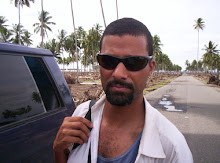 This is not Padang.
This is not Padang.This is Banda Aceh, on the northern tip of Sumatra, Nanggroe Aceh Darussalam, Indonesia. Over 100,000 people died here during the 26 December 2004 tsunami. Aid money flooded the region after the tsunami, funding projects like the massive vertical evacuation structure pictured above. Such a structure is not only effective in the face of another tsunami, but acts as a constant reminder of the threat that exists offshore.
Large earthquakes and tsunamis hit the north Aceh coast in 1907, and before that some 350 years earlier. Large earthquakes occurred elsewhere on the northern part of the Sunda subduction zone in 1887, 1881 and 1941. In 1833, the section of the Sunda arc offshore Padang ruptured in a large magnitude earthquake, sending a tsunami toward the then sparsely populated Padang. Should the same event happen today, the effects could be catastrophic.
Padang is the largest city on Sumatra's west coast- population ~800,000 or 3 to 4 times that of pre-tsunami Banda Aceh. Like Banda Aceh, Padang occupies flat coastal plain that offers little refuge from an incoming tsunami. And unlike Banda Aceh which has (had) a couple of kilometers of wetlands with aquaculture prior to the tsunami, most of Padang's population lies within 3 km of the coast.
A group of students from Standford University's Structural (http://www.stanford.edu/group/strgeo/) and Earthquake Engineering (http://blume.stanford.edu/) are working with Geohazards International (http://www.geohaz.org) and the Stanford School of Earth Sciences (http://ses.stanford.edu) to design a vertical evacuation structure in Padang, Indonesia. These groups are partnering with a local NGO, KOGAMI (http://kogami.multiply.com/) who is working on educating people toward disaster preparedness. Their goal is to design a building that could withstand an earthquake and serve as a refuge in case of tsunami.
For more information on this project, contact project manager Veronica Cedillos at Geohazard International.

No comments:
Post a Comment